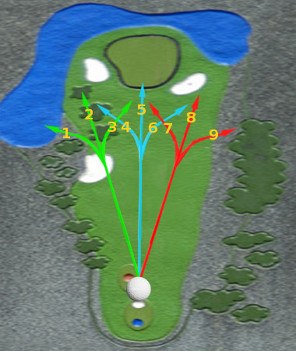Understanding why and how your golf ball curves during it's flight will allow you to quickly diagnose what is happening to your club during your golf swing and help you to efficiently correct and improve your movement so that you achieve the ball flight that you want.

Ball Flight Patterns:
1. Pull Hook
2. Pull
3. Pull Slice
4. Draw
5. Straight
6. Fade
7. Push Hook
8. Push
9. Push Slice
Ball Flight is Influenced by:
1. Clubhead Path
2. Clubface Angle
3. Loft At Impact
4. Clubhead Speed
*Ball flight laws only apply when proper alignment is observed.
A slice is a golf shot in which the ball starts on the left of the target (for a right handed golfer) and then curves to the right of the target, finishing off line to the right.
Conversely, a ball flight that starts to the right of the target and then curves to the left, finishing off line to the left of the target, is a hook.
The position of the club face as it strikes the ball is responsible for 85% of the golf balls initial start direction. Understanding this will allow you to obtain a better understanding of where the club face position was during impact, and therefore help you to make alterations and changes to the position to improve the ball flight. The path of the club, that is the direction that the club head was travelling in through impact, is responsible for only 15% of the golf ball's initial direction of flight.
To hit straighter shots that curve less in the air, initially work on improving the position of the club face as it connects with the golf ball.
A golf ball curves when there is a difference between the direction that the club head is travelling in (it's path) and the position of the club face at impact. The amount of difference between the club head path and the club face position is responsible for the amount of spin that is placed on to the golf ball, and therefore the amount of curve seen during the ball's flight. Any difference between swing path and face angle will cause the back spin axis of the golf ball to be tilted and this will result in a curving golf shot.
To be able to reduce the amount of curve you experience on your golf shots, achieve a balance between the club head swing path and the club face angle through impact. Work on the club face angle initially, and once this is improved, then work on achieving a more correct swing path to achieve a straighter, more accurate ball flight.






